COVER STORY
Studios, Teachers, and Coaches Adapt
Persevering and Building Community
BY MADELEINE MRAVKAROV AND ALESSANDRO SCALORA
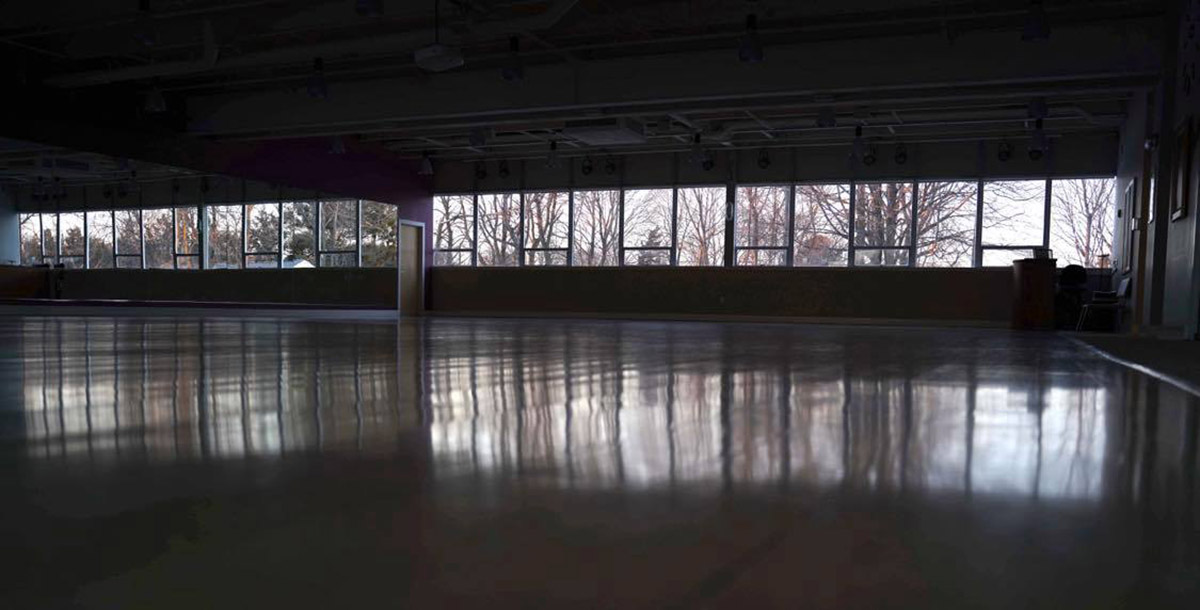
Photo Courtesy of Alexandru Munteanu
COVID-19 has forced many studios and clubs to shut down, with dancers, hungry to move, locked away at home. Communities that have been able to avoid quarantine are few and far between. The restrictions that have come hand-in-hand with the coronavirus have studios, teachers, and coaches turning to unconventional methods to keep their livelihood afloat. Needless to say, the ability to continue teaching during a global pandemic warrants immense creativity.
Katrina Volgina, the owner of Volga Dance Academy, took matters into her own hands as early as March 2020. “Our immediate response was to shut down the building and move all classes to Zoom within a week,” she recalled.
“We were fortunate to be able to seamlessly move to Zoom, and to have new kids join from other states and cities.” Although successful, the online classes were no match for in-person training. Within two months, Volgina was able to safely re-open the Atlanta-based studio, and also organized several in-person training camps. To accomplish that, they disinfected the studio, had all teachers and parents wear masks, worked in smaller groups, and continued to offer Zoom options.
Studio owners like Volgina, were not the only ones adjusting to the pandemic challenges. A few miles south, the Georgia Institute of Technology Dance Club was also getting creative.
“We were getting ready for the National Collegiate DanceSport Championships,” said Daniel Boman, an active collegiate athlete, recalling the initial lockdown. Unfortunately, not only were they unable to compete, but also after spring break, the campus was shut down, including the recreational center. They were unable to arrange any lessons.
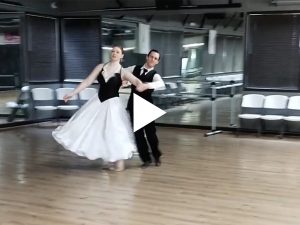
When the campus reopened in the fall, the club established new policies: “no dancing in partnerships, everyone had to be six feet apart, and temperature checks and hand sanitizer at the beginning of each lesson,” according to Boman.
Despite the new rules, the pandemic gave way to new opportunities for the club. “It’s been challenging, but we’ve had a lot of success in the back half of the semester,” said Boman. This included “15 or 20 new members as soon as we started in-person lessons.” In fact, the club had to “turn people away because we had too many people showing up.”
In order to keep the club’s sense of community, they organized group chats, social events, played board games online, and even arranged group viewing parties, where they watched and critiqued clips from previous dance competitions on YouTube.
All the way on the West Coast, USA Dance adjudicator and instructor Irina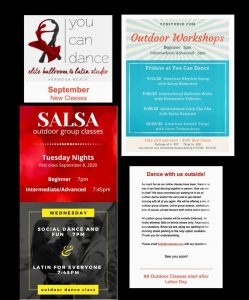 Trebunskaya took on the challenges that California’s restrictions presented her. “It’s California, so we took advantage of the weather and we built a dance floor outside,” she laughed. Unfortunately, before thanksgiving, they were forced to shut down and, similar to her counterparts in Georgia, used the Zoom platform to teach.
Trebunskaya took on the challenges that California’s restrictions presented her. “It’s California, so we took advantage of the weather and we built a dance floor outside,” she laughed. Unfortunately, before thanksgiving, they were forced to shut down and, similar to her counterparts in Georgia, used the Zoom platform to teach.
“We did manage, however, to do our winter gala showcase online” she added. “This is our biggest party of the year, every year, and we said ‘no, we can’t miss it.’ So, we did pre-record a lot of the dances, even prior to the shutdown.” The sheer thought of having a showcase “kept everyone alive!”
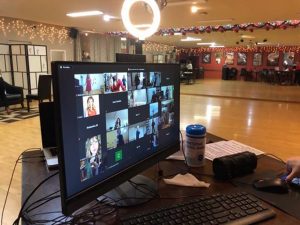
As for in-person lessons, Trebunskaya tries not to have more than two or three people in the studio at once, and keeps all four doors of the ballroom opened to increase ventilation. To reduce contact, she has her students dance with an “imaginary frame”. Although it might not feel the same as dancing with someone, her priority is making sure everyone is safe and healthy. She even sewed masks for herself, the teachers, and students boasting, “I probably made like 200 masks.”

California-based ballroom coach Ikaika Dowsett implemented a similar strategy. Due to the state’s strict restrictions, he and his students, who make up Team 106, were unable to physically meet up, so they settled for virtual gatherings. “Initially, we were doing a team movie night,” said Dowsett. They then transitioned to watching Blackpool Dance Festival videos together, reminiscent of the times when dancers could freely travel the world. “It’s become very clear how motivating the process of competing is to everyone.”
Although many have yet to compete, Boman and his partner took part in the Digital Collegiate DanceSport Challenge, held Oct. 30-Nov. 24. “It was nice to dance and get some feedback,” said Daniel. But sending video submissions online is very different from the atmosphere provided by sharing the floor with fierce competitors.
 Competing during this period of time may strike most as impossible, but in January, Volgina successfully organized an in-person and online version of the Atlanta DanceSport Cup, in cooperation with professional Vladimir Karpov.
Competing during this period of time may strike most as impossible, but in January, Volgina successfully organized an in-person and online version of the Atlanta DanceSport Cup, in cooperation with professional Vladimir Karpov.
Although USA Dance coaches and dancers found creative ways to cope with the pandemic, it was the large emphasis on community and shared determination that gave way to prosperity. Whether through Zoom calls, online competitions, or virtual movie nights, the hardships of 2020 have ironically brought the dance community closer together. “I would establish community as a core value,” suggested Dowsett.
As for COVID-19…“It’s all going to pass eventually,” noted Trebunskaya.
Doors Closed, but Dancers Dance On
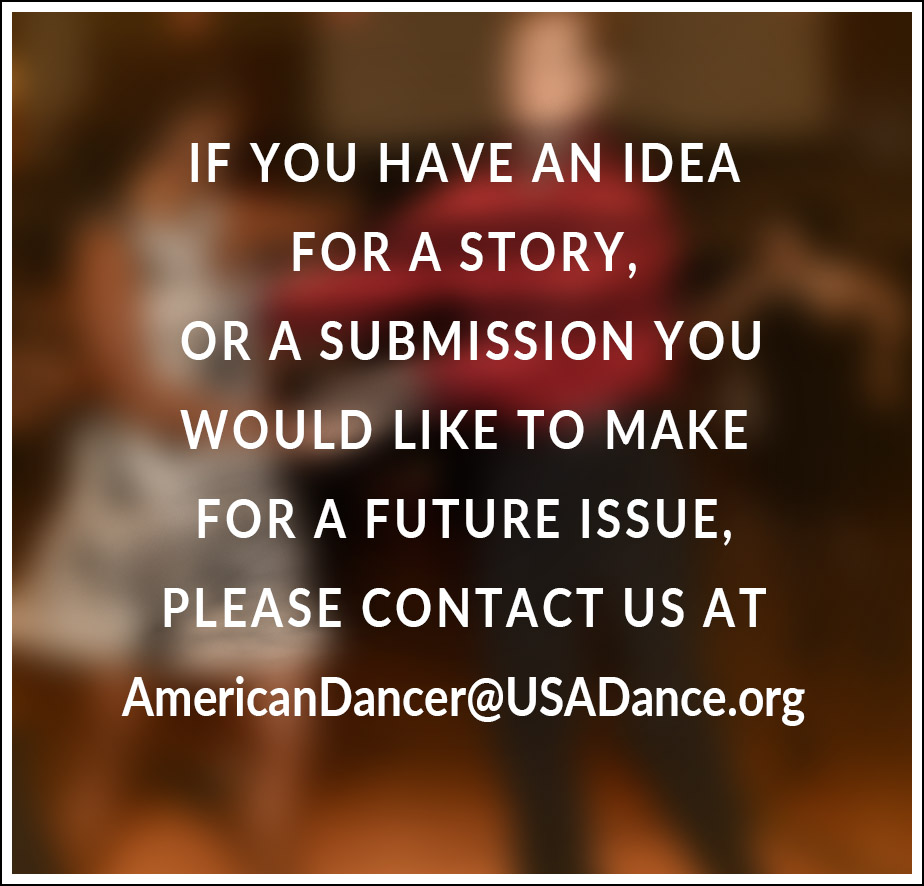
Busy Feet are Happy Feet
Perhaps unrealistically optimistic at first, USA Dance professional and adjudicator Ronen Zinshtein considered the first weeks of the pandemic much like an early spring break for his staff. However, as restrictions dragged on, his Natick, Massachusetts-based Todos Dance Studio and Fitness Center not only turned to Zoom, but embraced it wholeheartedly.
Together with his staff, he established a new business plan that focused on sessions that could effectively be taught via Zoom. They created many more online fitness classes, some with international clientele, and quickly realized that the Zoom classes were adding to their business. Months later, now that the studio is open, they continue to offer classes virtually, as some are viewed almost exclusively by out-of-state or outside-country clients.
To maintain good morale among his staff and students, Zinshtein decided to keep them very busy. He assigned them tasks, such as viewing old competitions and reporting specific observations regarding what they liked and did not like about their dancing. He suggested they observe other couples and bring in choreography ideas. With the staff, he challenged them to articulate their dance goals, business goals, and plans. He also gave them the American style syllabus and WDSF choreography to learn completely.
With his syllabus students, Zinshtein embarked on a systematic medal-based approach. His students were now required to master a level before being allowed to move up to the next. They rose to the occasion, and within a few months he had given over 80 exams. This not only added structure, but gave the students focus and something concrete to be working on during a difficult time.
Zinshtein thought it would be fun to create a TikTok video for the studio, which has since then accumulated more than a million “likes” and has over 30,000 followers. Unexpectedly, this has resulted in a lot of new business for the studio as many of the remote viewers of TikTok took advantage of the studio’s Zoom classes.
“In regard to the pandemic, it took a toll on all of us, but I think that it depends on what you are deciding to do with it. I’m not going to lie,” remarked Zinshtein. “There were days where I was like…I can’t do this anymore. Thankfully, I have a very good team to help me stand through all this. You have to find something each day that you can maybe do a little more…I believe having that mentality helped us get through this.”
